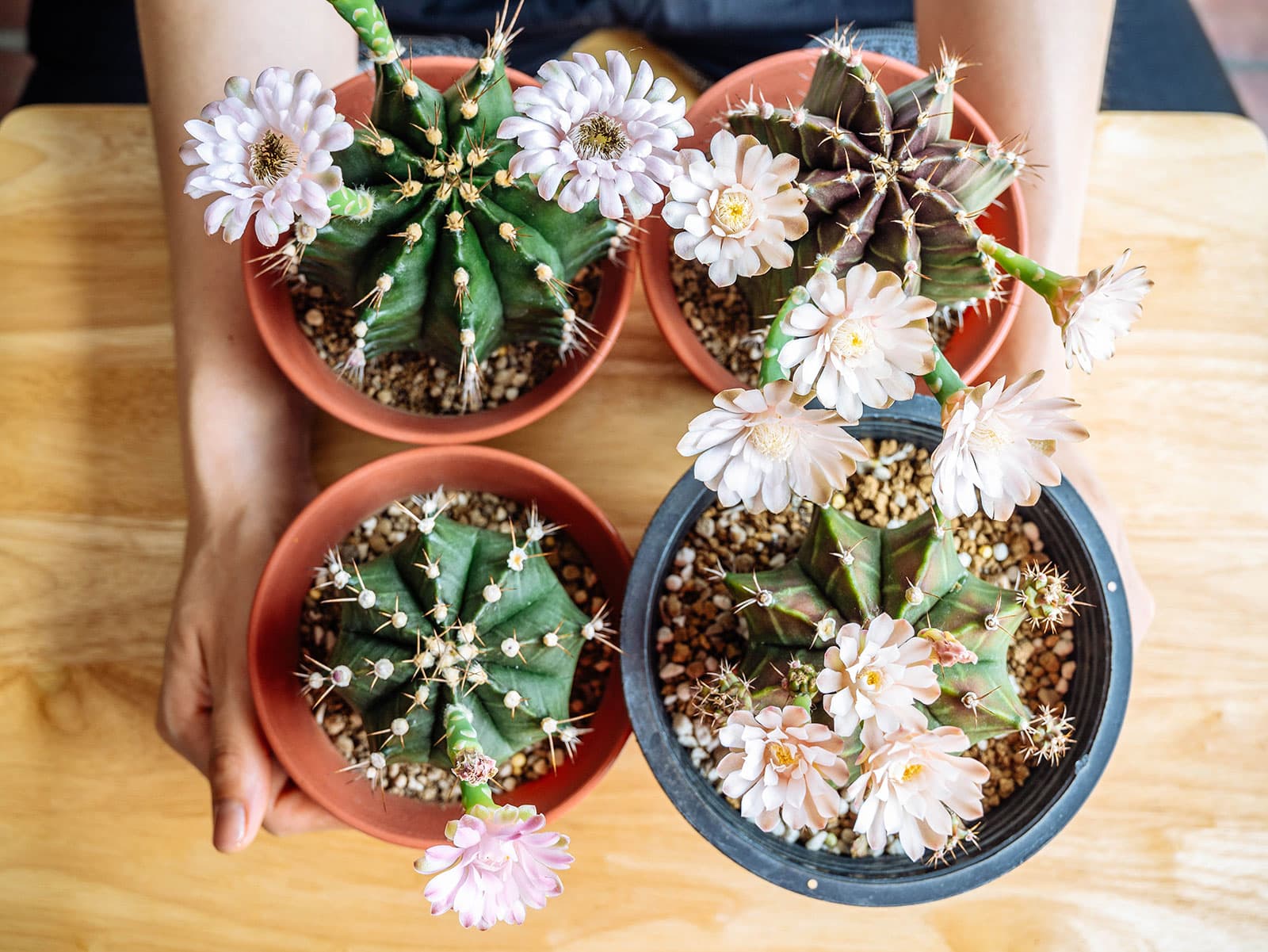If you’re looking for a pretty flowering houseplant to add to your collection, a cactus may not be the first thing that comes to mind.
But! Many of these spiny plants actually bloom surprisingly extravagantly. Say goodbye to fake paper flowers and super glue: the real thing looks way better, and it’s not too difficult to get your cactus to produce flowers either.
Related: 9 of My Favorite Flowering Succulents That Are So Easy to Grow
Below, let’s have a look at 9 of my favorite cacti with flowers, each of which rivals orchids or lilies with ease. Which one’s your favorite?
Disclosure: If you shop from my article or make a purchase through one of my links, I may receive commissions on some of the products I recommend.
Best places to buy cacti:
Schlumbergera sp. (holiday cactus)
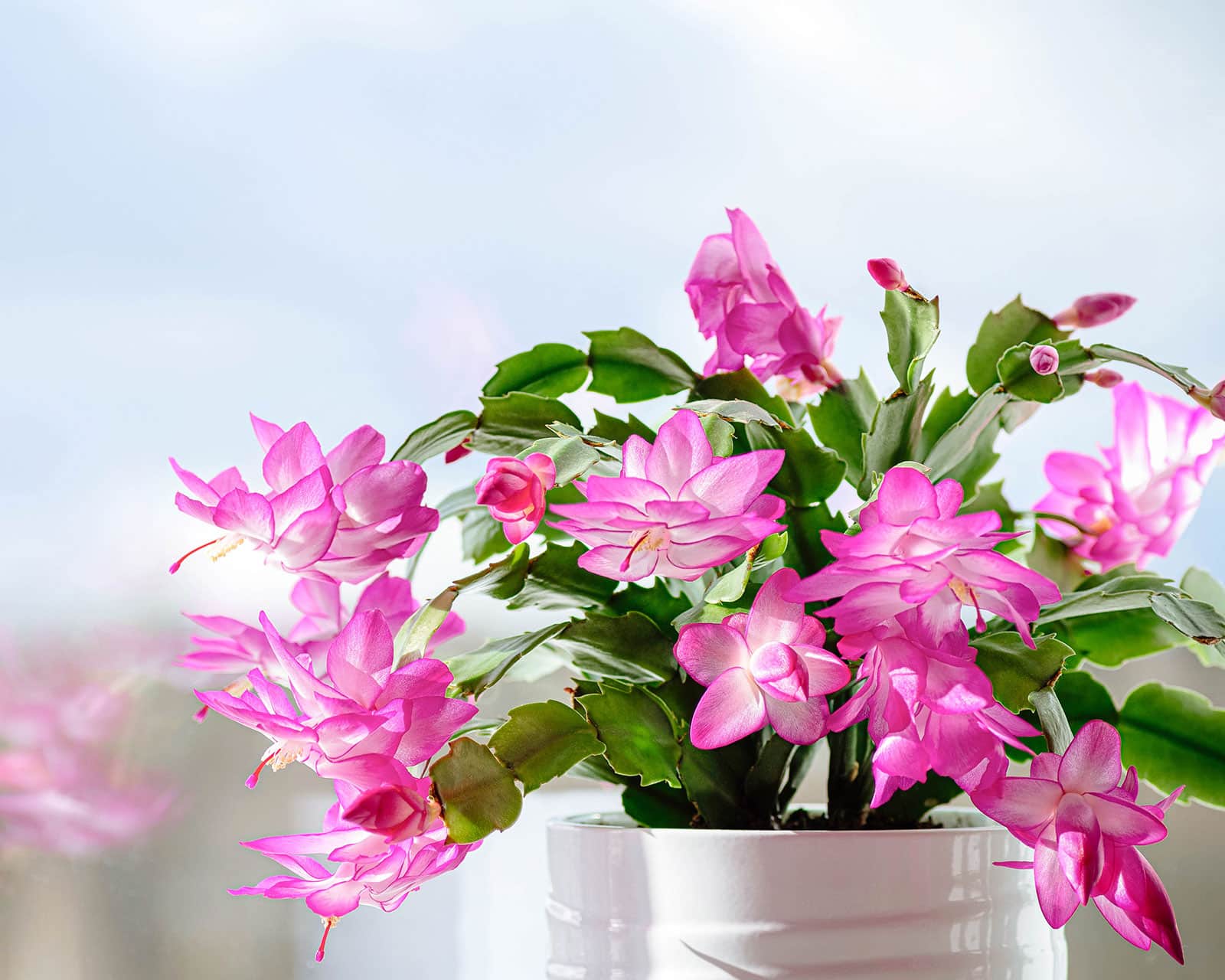
If you’re into houseplants, you probably saw this one coming. The holiday cacti of the genus Schlumbergera are immensely popular for indoor growing, mostly due to their spectacular blooms. (You can even get your holiday cactus to bloom more than once a year!)
Read more: 10 Cheery Holiday Houseplants to Grow If You’re Bored With Poinsettias
Selective cultivation of this flowering cactus has led to the creation of a true rainbow of different blooming shades: red, white, yellow, orange, and even hot pink.
Schlumbergera currently contains six species (or nine, depending on who you ask). Three of them inevitably pop up in stores around different holidays:
- Schlumbergera truncata: This one’s often sold as ‘Christmas cactus’, but that common name is already taken by the species below. To help avoid confusion, the name ‘Thanksgiving cactus’ has now gained popularity for this winter bloomer. You’ll recognize it by the toothed leaf segments.
- Schlumbergera x buckleyi: The result of a cross between the aforementioned S. truncata and another Schlumbergera cousin named S. russelliana. This is the “true” Christmas cactus, although it’s not sold on the same huge scale as the Thanksgiving version.
- Schlumbergera gaertneri: Until recently, this spring bloomer, also known as the ‘Easter cactus’, was considered to be part of the genus Hatiora. It has now been moved to Schlumbergera. You can tell it apart from the others by its more rounded leaf segments and star-shaped flowers.
Holiday cacti naturally grow in forested or jungle habitats, so they like a little more water than “regular” cacti.
Opuntia sp. (prickly pear)
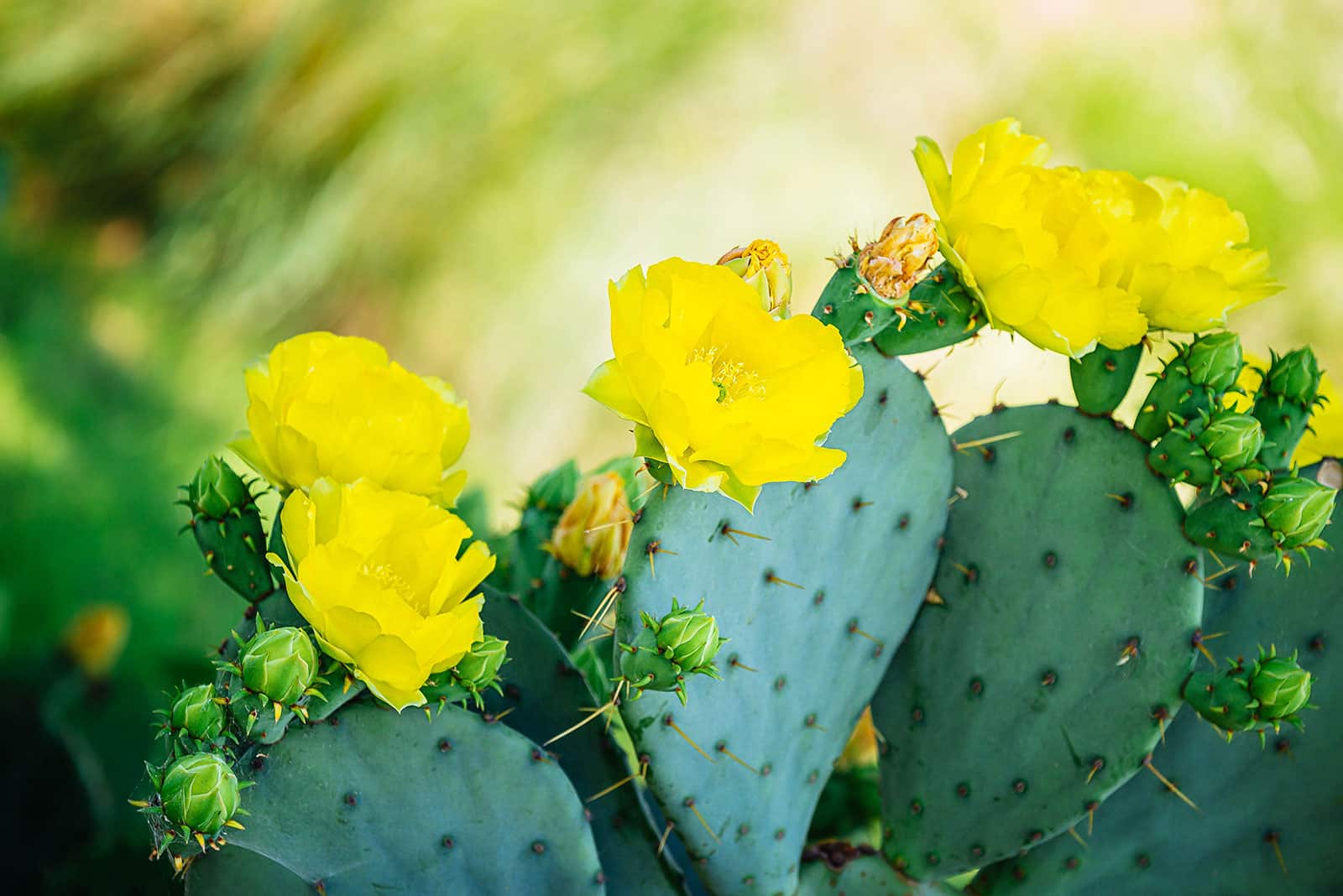
The genus Opuntia, also known as prickly pear or nopal, is one of those ubiquitous cacti that we’re all familiar with.
There are dozens of different Opuntia species, although the two most widely known members of the genus are Opuntia ficus-indica (the Indian fig Opuntia, which produces edible fruits referred to as cactus pears or figs) and Opuntia microdasys (the small and fuzzy-looking bunny ears cactus).
In the wild, these cacti can be found throughout almost all of the American continent. They naturally pop up as far south as southern Argentina and as far north as Canada. Most of them bloom beautifully, producing big yellow, orange, or even pink flowers.
Really any species of Opuntia works if you like pretty flowers, but my personal favorite has got to be Opuntia gosseliana. This one doesn’t just bloom wonderfully, but its leaf segments also take on a nice purplish hue (rather than the regular green) when exposed to plenty of sun.
If you don’t live in the tropics but would like to keep your cactus outdoors year-round, you may be interested in the closely related Cylindopuntia imbricata.
Also known as the cholla cactus, this species can survive temperatures as low as -5°F as long as you keep its substrate dry. Don’t touch it though, as its spines are famous for their ability to lodge themselves in your skin!
Echinopsis sp. (hedgehog cactus)
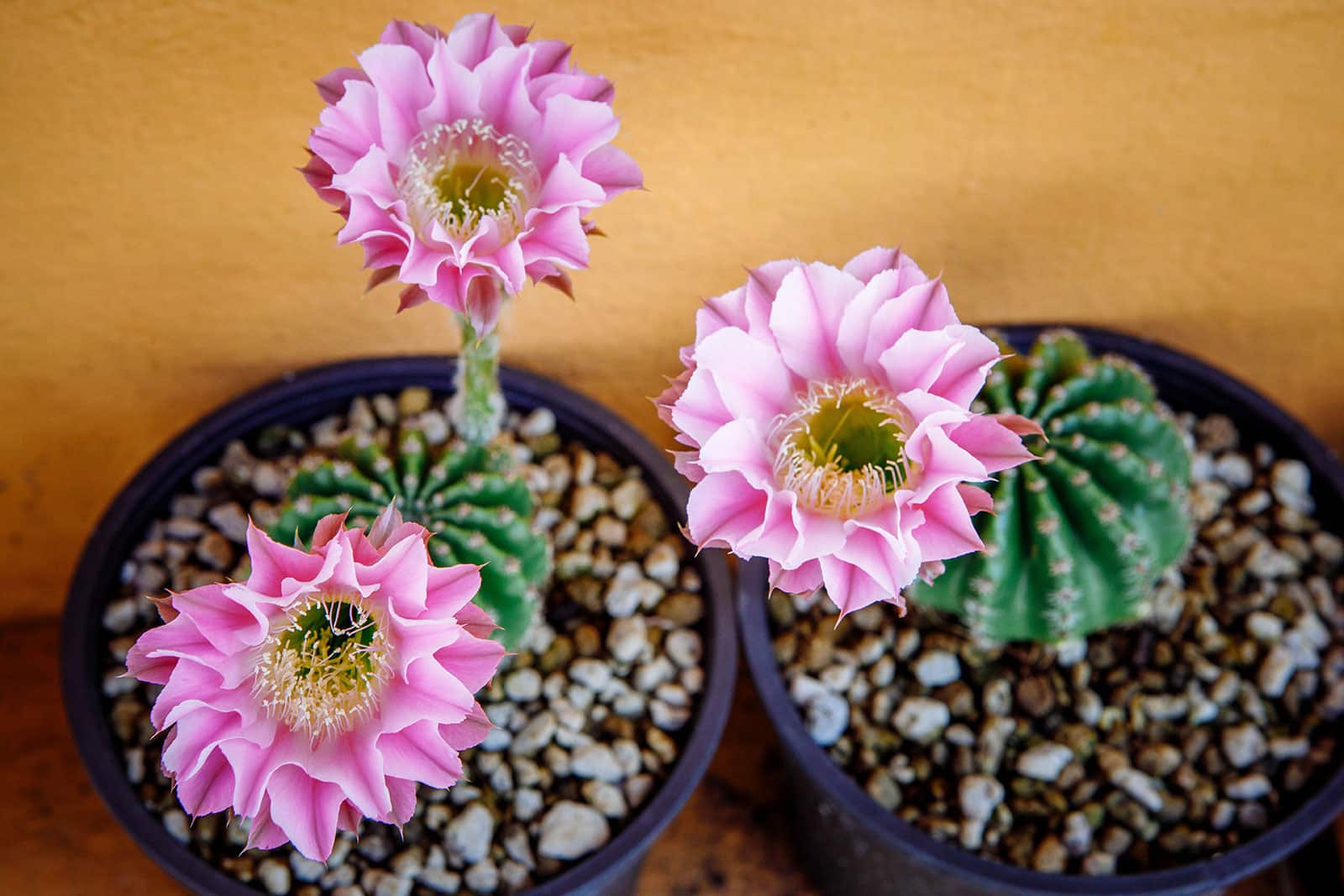
Why hello, Echinopsis! This genus of orb and cylinder cacti is a true winner when it comes to cactus flowers. Its members are naturally found in South America, but many have become popular worldwide for indoor and balcony growing.
I’d be hard-pressed to select a favorite Echinopsis, but I have to say that one of the most spectacular bloomers is definitely Echinopsis oxygona, the hedgehog cactus. Another fantastic choice for a cactus with flowers is Echinopsis subdenudata, also quite appropriately known as the Easter lily cactus.
As long as they get enough water (they tend to need more than you think!) and sunlight, these cacti will regale you with their blooms over summer.
First, a hairy and rather unsightly protrusion pops out of the plant, becoming longer and longer over the course of several days. Once you spot a tapered bud at the end, start paying attention, because the actual flower usually opens at night and often withers within 24 hours.
If you don’t want to miss the spectacle, it may be a good idea to take a peek at your Echinopsis every hour or so after sundown. You could even point an old phone at the plant to record a timelapse video, like the ones shown here. Amazing!
Rebutia perplexa

Whereas Echinopsis cacti impress with their single massive flower, Rebutia perplexa prefers not to put all of its eggs in one basket.
You can’t miss this clustering orb cactus in your collection if you’re looking for a nice cactus with flowers! It’s easy to care for, and in spring, produces a myriad of gorgeous little pink flowers.
Cacti of the genus Rebutia are naturally found in Bolivia and Argentina. Like most cactus species, they like plenty of light, and they prefer for their soil medium to dry out fully before being watered again.
If you like Rebutia perplexa, don’t forget to also check out the other species in this genus.
Those looking for a cactus with white flowers, could consider Rebutia albiflora. If you prefer orange, maybe Rebutia albopectinata is the cactus for you. The taxonomy for this genus is a bit of a mess, but there are at least a dozen different species to choose from.
Epiphyllum sp.

The genus Epiphyllum, like the Schlumbergera holiday cacti we discussed earlier, is a jungle cactus. These unusual cacti can be recognized by their flat leaf segments: quite different from the “standard” orb- or pillar-shaped desert cacti.
Jungle cacti like higher air humidity levels than their desert cousins, and they also prefer more regular watering. Oh, and they bloom fantastically. Seriously, their common name is “orchid cactus” for a reason! As if that wasn’t enough, their flowers also smell divine.
The most well-known species in this genus is called Epiphyllum oxypetalum, common name Dutchman’s pipe cactus. This species hails from forested areas in Mexico and Guatemala, where it blooms between spring and late summer.
As with many cacti, an Epiphyllum’s flowers open at night, so be sure to keep an eye on the buds or you might miss the fireworks.
Did you know? Some cacti that used to belong to the genus Epiphyllum have now been moved to the closely related Disocactus. These also include some extravagant bloomers, like the popular fishbone cactus (Disocactus anguliger).
Selenicereus sp.

Nope, you’re not seeing double. The gigantic, cream-colored and divine-smelling flowers produced by the genus Selenicereus are very similar in looks to those of the aforementioned Epiphyllums.
Selenicereus are also jungle cacti, usually found growing in an epiphytic or lithophytic manner on trees or rocks (not unlike Tillandsias).
The most popular species of Selenicereus used to belong to Hylocereus (I’m sure you’ve concluded by now that cactus genera and taxonomy are by no means stable; species are moved around all the time).
You may have seen them at the supermarket, labeled pitahaya, pitaya, or dragonfruit. Yep, this edible fruit comes from a cactus, one that also produces spectacular blooms.
Dragonfruit cacti really do make an ideal addition to any cactus collection. How many other houseplants have the capacity to produce both gorgeous flowers and tasty fruit?!
The one you’re most likely to be familiar with is Selenicereus undatus, which produces tasty pink-skinned and white-fleshed dragonfruits.
All this being said, there’s more to the genus Selenicereus than just the fruit-bearing pitahayas. There are around 30 species in total!
Selenicereus anthoyanus, for example, looks almost like a carbon copy of the previously mentioned fishbone cactus. It’s actually often sold under the same name, but it can be told apart by its longer stems and fantastic pink-hued flowers.
Did you know? The name ‘Selenicereus’ is a reference to the Greek moon goddess Selene. Surprise, surprise… this one also blooms at night.
Astrophytum sp.

Alright, let’s circle back to desert cacti for the remainder of this list. You’ve probably seen Astrophytums for sale at your local plant store or garden center, as it’s one of the most popular types of cacti out there.
Most of this orb-shaped genus is naturally found in Mexico, although it has to be mentioned they’re actually pretty rare in their natural habitat.
The most popular Astrophytum among collectors is A. asterias, which is appreciated almost as much for its beautiful colors as it is for its lovely blooms. It’s even available in a variegated version, which sports hues like yellow, red, and orange and can go for slightly exorbitant prices. Another species in the genus you’ll often see for sale is Astrophytum myriostigma.
These cacti bloom in summer, usually producing a single flower right on top of their crown. The flowers are usually cream or yellow in color, but there are also cultivars that bloom more abundantly and in pink.
Remember that it might be a while before your Astrophytum feels ready to bloom for the first time, as this is a rather slow grower that requires a bit of patience on your end.
Mammillaria sp.
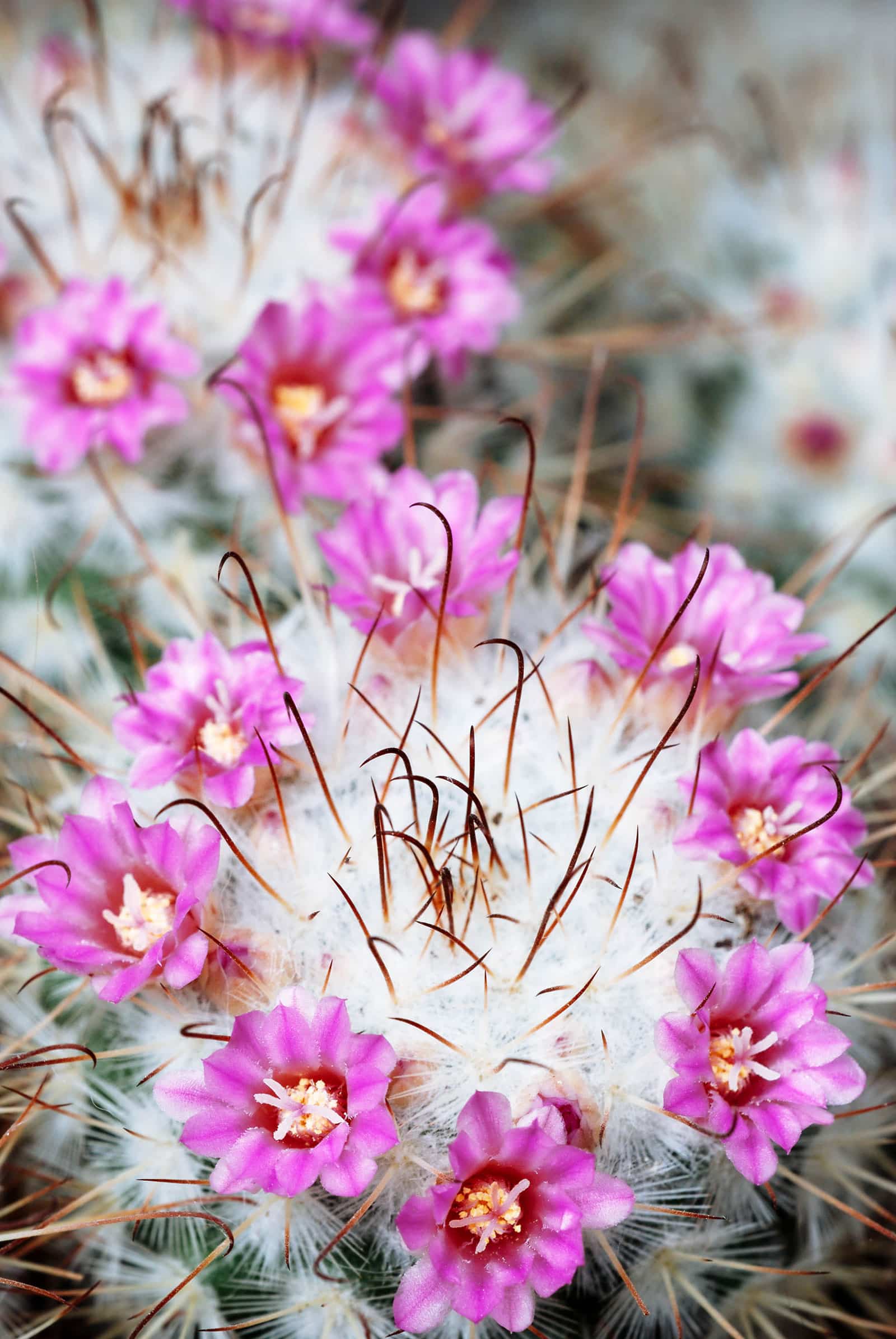
More experienced cactus enthusiasts were probably wondering when I was finally going to discuss Mammillaria. Well, here it is in all its blooming glory!
This genus is the largest in the cactus family Cactaceae, containing over 200 species, so it’s no surprise there are some lavish bloomers among them. The tiny flowers tend to grow in a ring around the top part of the cactus, like a colorful little flower crown.
Mammillaria cacti are immensely popular. You’ll find them in any garden center or plant store that carries cacti, unfortunately usually with faux straw flowers glued on. They’re orb-shaped to cylindrical and can form large clusters.
Most species are pretty easy to care for and are considered beginner-proof, so no worries if you don’t have much experience with cacti yet.
I’d need to write an entire book to discuss all Mammillaria species, but here are some of my favorite bloomers:
- Mammillaria blossfeldiana: A small cactus with hooked spines and an abundance of gorgeous star-shaped flowers in shades of pink and white.
- Mammillaria baumii: Relatively large, yellow flowers.
- Mammillaria bocasana: A hairy cactus with hooks and tiny pink blooms.
- Mammillaria spinosissima: You’ve probably seen this one at some point. Lots of small spines and a lovely pink flower crown.
Gymnocalycium sp.
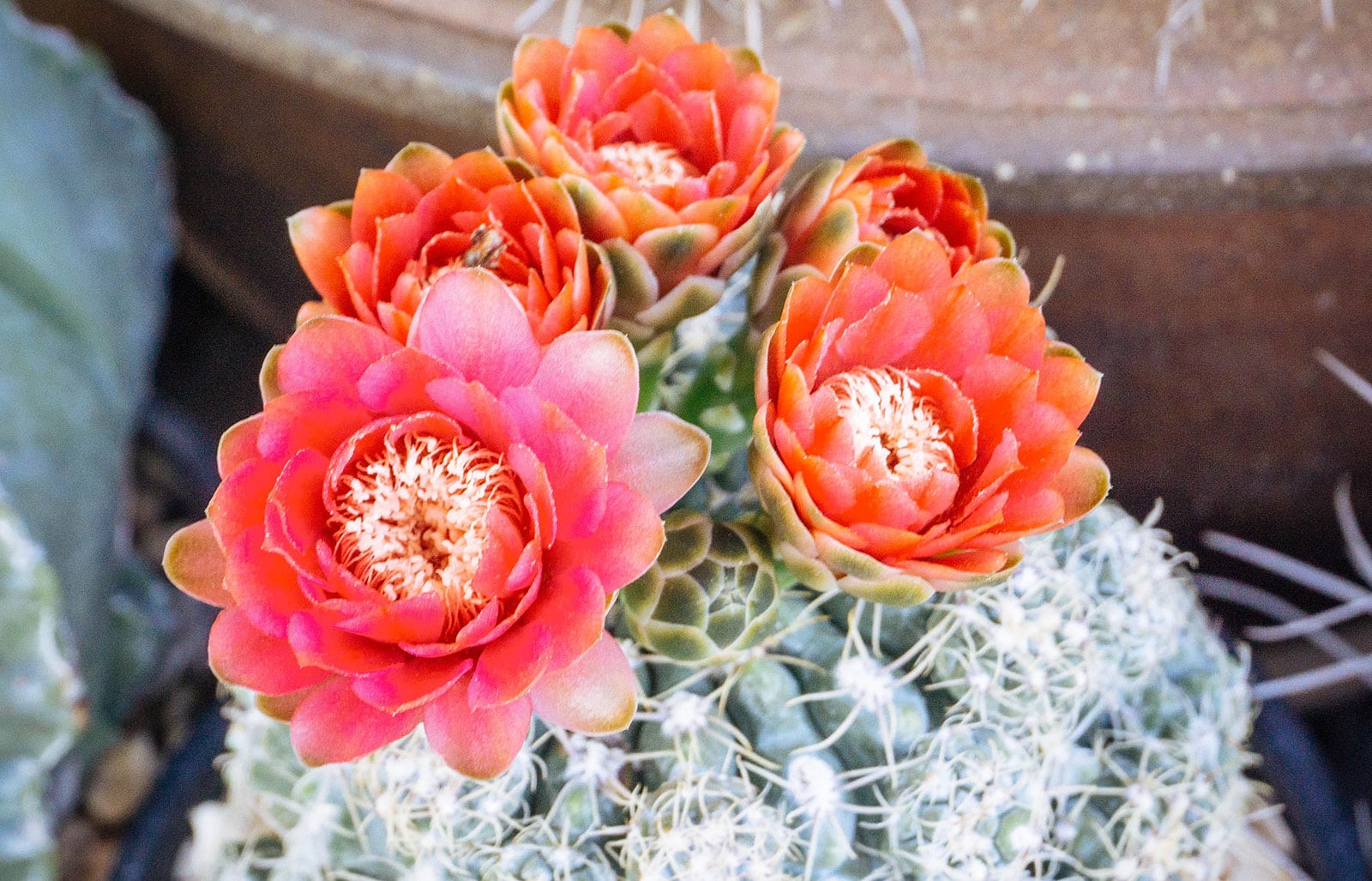
Some of the species in the genus Gymnocalycium are among the most beautiful in the entire cactus family. The most popular is Gymnocalycium mihanovichii, which can be bright red, orange, or yellow in color.
I can guarantee you’ve seen this one before: it’s the colored orb on top of a grafted moon cactus!
However, this genus has much more to offer than just one colorful crowd-pleaser. There are about 70 species in total, the majority of which are easy enough to care for and bloom wonderfully. The one in the photo above, for example, is Gymnocalycium baldianum.
Other popular species include:
- Gymnocalycium saglionis: Features large spines and a pretty crown of white to pink flowers.
- Gymnocalycium horstii: One or two large, pastel pink blooms.
- Gymnocalycium chacoense: A crown of sweet white-pink flowers.
- Gymnocalycium baldianum: An abundant bloomer in shades of purple and pink.
How do I get my cactus to bloom?
If you’ve had a few cacti on your windowsill for years and are now left wondering why you’ve never spotted any flowers, don’t worry. It’s probably not your fault!
Cacti grown indoors in a small planter just don’t bloom quite as often or copiously as their outdoor counterparts do. If light is lacking or the watering balance is off, they may not have the energy to produce any flowers at all.
Does this mean you can go ahead and forget about cactus flowers unless your climate is right for growing these desert dwellers outdoors?
Nope! There are absolutely some things you can do to increase the chances of your cactus blooming.
First off, desert cacti (the plump ones) like gritty potting soil. They can’t stand excess moisture and are sensitive to rot, but they do like a sip of water once their soil has gone completely dry. Do make sure to use a planter with a drainage hole in order to allow excess water to drain freely.
The other key to growing cacti successfully is light. Unless you’ve got a jungle cactus on your hands, which can make do with indirect light, yours will appreciate receiving as much sun as possible. Sometimes even a bright, south-facing window isn’t enough to give them what they need and keep them from stretching!
The solution to the light problem is placing your cactus outdoors in summer. Basically, around May, or whenever temperatures are consistently above 50°F at night, find your plant a sunny but sheltered spot in your garden or on your balcony/deck. Once night temps drop below 50°F again in fall, you can bring it back indoors.
I’ve experimented with sending my cacti on “outdoor summer camp” quite a bit and I’ve found that it’s definitely the number one thing you can do to encourage flowering. The first wave of blooms usually occurs in the second growing year, but some cacti are show-offs and will start earlier!
Just remember that a cactus grown outdoors will need more water than indoors, especially during hot and dry summers.
Best places to buy cacti:


